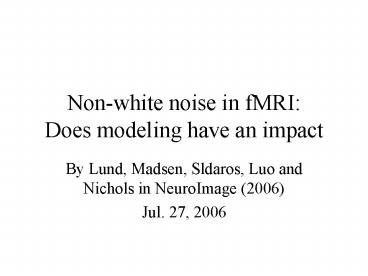Nonwhite noise in fMRI: Does modeling have an impact - PowerPoint PPT Presentation
1 / 17
Title:
Nonwhite noise in fMRI: Does modeling have an impact
Description:
3. Modeling aliased physiological noise ... Investigation into resting state connectivity using Independent component analysis ... – PowerPoint PPT presentation
Number of Views:27
Avg rating:3.0/5.0
Title: Nonwhite noise in fMRI: Does modeling have an impact
1
Non-white noise in fMRIDoes modeling have an
impact
- By Lund, Madsen, Sldaros, Luo and Nichols in
NeuroImage (2006) - Jul. 27, 2006
2
GOAL
- 1. To remove temporal autocorrelation remaining
even after whitening step (rigid body
transformation) - ? Nuisance Variable Regression (NVR)
- 2. To demonstrate the modeling effect by some
diagnostic tools with some data sets, e.g.,
simulated data, phantom data.
3
Noises and the effect on true signal
- Possible noises Low frequency drift due to
hardware imperfection, oscillatory noise due to
respiration and cardiac pulsation, residual
movement artefacts - These noising factors induce temporal
autocorrelation, invalidate statistical analysis - since statistical analysis assume the residuals
are independent and identically distributed
normal
4
Background knowledge in noise
- Low frequency oscillation is nature which is
found in cadaver and phantom. - Typically, in brain acquisition, the
physiological noise components are heavily
aliased and non-stationary ? No commonly accepted
standard noise model.
5
Background knowledge in noise (Contd)
- A real signal S is sampled at frequency
- Then, the frequency (detected from the
sampled signal), which is - is aliased with the frequency
- - Nyquist theorem
6
- Nonwhite noise sources
- 1. Low frequency drift due to hardware
instability - Commonly used model is to include a basis set of
slowly varying functions (in fmristat by Worsley
and Friston, 1995) - Discrete cosine set (in SPM2)
7
(No Transcript)
8
- 2. Residual Movement effect which can be present
in the data even after rigid body transformation
(Friston et al. 1996) - m_i(t) is the 6 rigid body movement parameter of
the volume at time t_n
9
- 3. Modeling aliased physiological noise
- RETROICOR method, (Glover et al. (2000)) models
the physiological noise as a basis set of sine
and cosine.
10
- Where are coefficeints of sines and
cosines describing the five harmonics of the
cardiac noise and - are the coefficients of sines and cosines
of describing 3 harmonica of the respiratory noise
11
- RETROICOR method
12
(No Transcript)
13
Nuisance Variable Regreesion
- Nuisance Variable Regression (NVR) is
- obtained by combining three components of
14
(No Transcript)
15
(No Transcript)
16
Diagnostics
- Testing assumptions in general linear model
- Testing on whiteness and normality
- By using Statistical Parametric Mapping
diagnostics (SPMd) - Test statistics
- BLUS residuals, Durbin-Watson (whiteness)
- Shapiro and Wilk (normality)
17
Next presentation!
- Investigation into resting state connectivity
using Independent component analysis - By Beckmann, et al. (2005)
- It allows the scientific investigation in order
to characterize the identification of low
frequency resting state patterns

